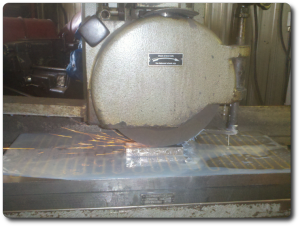Grinding consists of removing material from a workpiece with the use of a rotating abrasive wheel or disk. While rotating, each particle of the grinding wheel removes a small chip of the workpiece material as its abrasive edges make contact with the workpiece, usually at high speed.
Cylindrical Grinding, as its name implies, has to do with the grinding of cylindrical shaped objects, parts or components. Also known as “center-type grinding”, this grinding process is done with a part, or workpiece, held in place between two centers by a carrier (also called a lathe dog or a grinding dog) which transfers the rotation movement from the spindle. The grinding disk or wheel, installed on a seperate spindle can be ajusted at various angles depending on the workpiece final requirements.
In the case of Surface Grinding, the workpiece is held in place on a flat surface either by an electromagnet, by vacuum or some mechanical means. Surface Grinding is used primarely to obtain a desired surface finish or smoothness, precise angularity, perpendicularity and flatness tolerances.
As for other grinding methods, some of the advantages of cylindrical and surface grinding are:
Grinding in very hard materials
- Ability to produce very smooth and precise surfaces, which in turn allows for higher mechanical quality and performance
- Ability to attain tolerances in the tenths of thousands of an inch (i.e. 0.0004″)
- Ability to attain precise roundness, concentricity and flatness tolerances
Read more: Cylindrical & Surface Grinding





